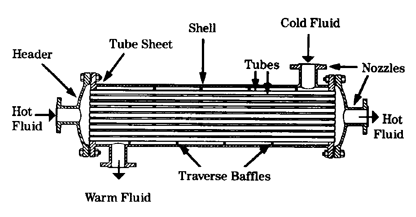|
Heat exchanger
A heat exchanger is a device built for efficient heat transfer
from one fluid to another, whether the fluids are separated by
a solid wall so that they never mix, or the fluids are directly
contacted. They are widely used in refrigeration, air conditioning,
space heating, power production, and chemical processing. One
common example of a heat exchanger is the radiator in a car, in
which the hot radiator fluid is cooled by the flow of air over
the radiator surface.
Types of heat exchangers
A typical heat exchanger is the shell and tube heat exchanger
which consists of a series of finned tubes, through which one
of the fluids runs. The second fluid runs over the finned tubes
to be heated or cooled.

Another type of heat exchanger is the plate heat exchanger. It
directs flow through baffles so that the fluids are separated
by plates with very large surface area. This plate type arrangement
can be more efficient than the shell and tube. Advances in gasket
technology have made the plate type increasingly practical.Now
plate type heat exchangers is a standart for HVAC applications
A third type of heat exchanger is the regenerative heat exchanger.
In this, the heat from a process is used to warm the fluids to
be used in the process, and the same type of fluid is used either
side of the heat exchanger. (These heat exchangers can be either
plate and frame or shell and tube construction.)
A fourth type of heat exchanger uses an intermediate fluid or
solid store to hold heat, which is then moved to the other side
of the heat exchanger to be released. Two examples of this are
adiabatic wheels, which consist of a large wheel with fine threads
rotating through the hot and cold fluids, and heat exchangers
with a gas passing upwards through a shower of fluid (often water)
and the water then taken elsewhere before being cooled. This is
commonly used for cooling gases whilst also removing certain impurities,
solving two problems at once.
PHE ,Plate Heat Exchangers
HYDRONIC HEAT-DISTRIBUTING UNITS AND
RADIATORS
|

